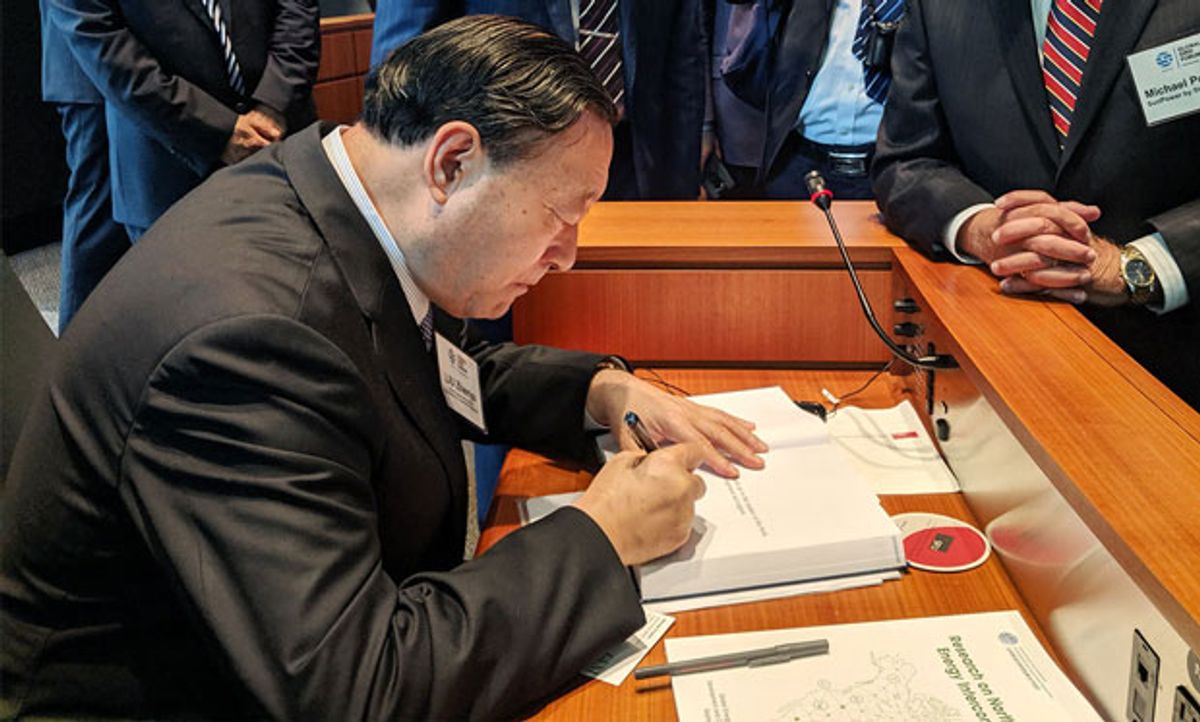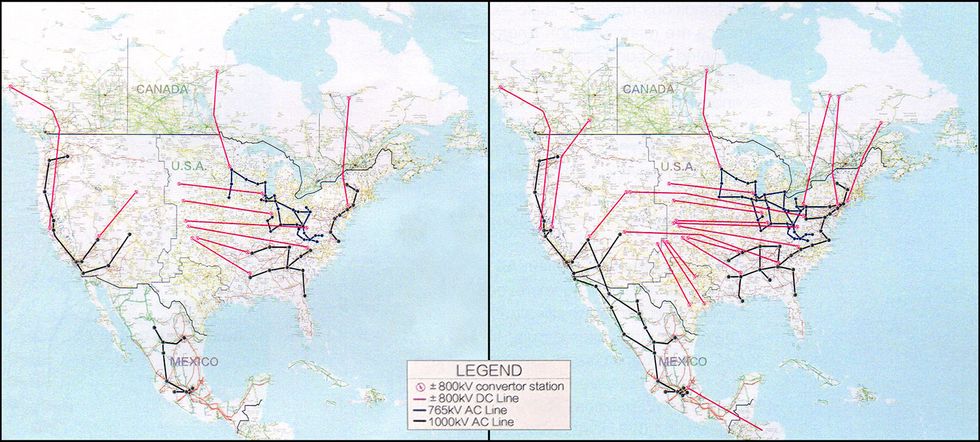Transmission lines in the United States and Canada require approval from every state and province traversed, and that political fragmentation hinders deployment of long power links of the type connecting vast swaths of territory in regions such as China, India, and Brazil. As a result, few studies detail how technologies that efficiently move power over thousands of kilometers, such as ultrahigh-voltage direct current (UHV DC) systems, might perform in North America. Earlier this week, the Beijing-based Global Energy Interconnection Development and Cooperation Organization (GEIDCO) stepped in to fill that gap, outlining an ambitious upgrade for North America’s grids.
GEIDCO’s plan promises to greatly shrink North America’s carbon footprint, but its boldest prescriptions represent technical and economic optimizations that run counter to political interests and recent trends. “Thinking out of the box is how you solve complicated, difficult problems,” said former Southern California Edison CEO Ted Craver in response to the plan. But GEIDCO’s approach, he said, raises concerns about energy sovereignty that could prove difficult to settle. As Craver put it: “There’s theory and then there’s practice.”
The proposed North American transmission scheme was unveiled on Tuesday at an international transmission forum in Vancouver, Canada, by Liu Zhenya, the former State Grid Corp. of China chairman who launched GEIDCO in 2016. While at State Grid, Liu championed the development of the world’s first 800- and 1,100-kilovolt UHV DC lines and the first 1,000-kV, UHV AC transmission. State Grid has deployed them to create a brawny hybrid AC-DC electricity system that taps far-flung energy resources to power China’s densely-populated and industrialized seaboard.
Through GEIDCO, Liu is proselytizing for UHV deployment worldwide. At the Vancouver meeting, Liu warned of “unimaginable damage to mankind” if greenhouse gas emissions continued at their current pace. He argued that beefy grids moving power across and between continents are a prerequisite for accessing and sharing the world’s best wind, solar, and hydropower resources, and thus dialing-down fossil fuel consumption.
GEIDCO’s plan for North America mirrors the combination of UHV AC and DC transmission deployed by State Grid in China. In that scheme, a series of 800-kV UHV DC lines running east to west across the U.S. would share wind and solar power widely, while north-south lines would provide continent-wide access to Canada’s giant hydropower plants [see map below]. One more UHV DC line—a 5,200-kilometer stretch from Mexico to Peru—would enable power exchanges with South America.
As in China, UHV AC lines would be added atop North America’s five existing AC grids, strengthening them so they could safely absorb the 8-gigawatt output of each DC line. In two cases, UHV AC would eventually cross boundaries between distinct AC grids to create larger and more stable synchronous zones: Mexico’s grid would fold into the larger grid that currently covers the Western U.S. and Canada; and Texas’ grid would merge with North America’s big Eastern grid.
Consolidating grids helps explain the benefit of GEIDCO’s plan. Texas’ grid is only weakly linked to its neighbors at present, which limits its ability to share resources such as extra wind power that may go to waste for lack of in-state demand or to important renewable power when its wind farms are still. GEIDCO’s UHV build-out unlocks such resources by enabling each power plant to serve a larger area.
The payoffs are numerous. Electrification to decarbonize vehicles, home heating, and industries would proceed 60 percent faster than the most ambitious U.S. electrification scenarios projected by the Electric Power Research Institute. Renewable energy installation would also accelerate, pushing the share of zero-carbon energy on the continent from 40 percent of the power supply in 2017, to 64 percent in 2035, and 74 percent in 2050. Nuclear energy’s contribution would fall by nearly half to just 11 percent of generation in 2050—mostly due to its higher cost, according to GEIDCO director of energy planning Gao Yi. Overall, energy-related greenhouse gas emissions would drop 80 percent by 2050, relative to a business-as-usual scenario—even as average power generating costs drop.
However, consolidating grids is also where the political sensitivity begins. Texas fiercely guards its independent AC grid, which shields its power industry from oversight by federal regulators. Craver’s take on the prospects for bringing Texas into the fold: “Good luck on that.”
Broader political concerns, meanwhile, could hold up international UHV links. Deeper integration of power supplies across borders implies a high level of trust between nations. That cuts against the recent trend toward populist governments advocating more nationalist agendas, as exemplified by the U.K.’s ongoing effort to leave the European Union.
A populist Mexican President elected last year has blocked international investment in renewable energy and could undo recent efforts to expand the country’s grid interconnections. U.S. President Trump has decreased trust in the United States as an international partner with his America-first trade policies and plans to withdraw the U.S. from global pacts such as the Paris Agreement on Climate Change.
At the Vancouver forum, organized by the Edison Electric Institute, a Washington-based trade group, most grid experts identified politics and social acceptance as the greatest challenges to power network expansion. In the U.S., climate and energy policy has made it more difficult for government researchers to even study North American grid integration.
Last year, political appointees at the U.S. Department of Energy blocked publication of a modeling study exploring integration of the Eastern and Western grids via DC lines. The study, led by the grid modeling group at the National Renewable Energy Lab (NREL) in Boulder, Colo., projected that long DC lines linking the grids would reduce power costs and accelerate renewable energy development. According to the study’s leader, it showed that “building national-scale transmission makes sense.”
NREL’s grid modelers are now wrapping up a larger continent-wide study looking at the challenges and opportunities for grid integration of very large levels of wind, solar and hydropower. That North American Renewable Integration Study is a collaborative effort by the U.S., Mexican, and Canadian governments. It was supposed to be completed this month, but remains under review by the three governments.
Peter Fairley has been tracking energy technologies and their environmental implications globally for over two decades, charting engineering and policy innovations that could slash dependence on fossil fuels and the political forces fighting them. He has been a Contributing Editor with IEEE Spectrum since 2003.




